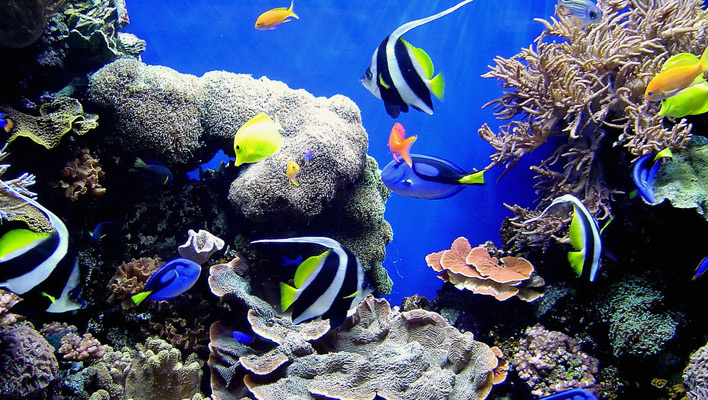Since we launched Saltwater Smarts, we’ve been sprinkling the term “aquascaping” into our posts with reckless abandon. While many of you seasoned salties out there might be well acquainted with this term, others may find themselves scratching their heads each time they come across it.
Aquascaping simply refers to the manner in which the rockwork, substrate, and any décor items are arranged in the tank—like landscaping, only under water. While there’s certainly an aesthetic component to aquascaping, its true significance goes well beyond visual impact.
Here are some simple tips to keep in mind as you plan and implement your own marine aquarium aquascape:
Design with livestock in mind
The first thing to consider as you develop your aquascape is the type of livestock you plan to keep. Fish, for instance, can have very different aquascaping needs depending on the species. Some, including many tangs, need ample open swimming space, whereas others, such as the various clownfishes, are more site-attached and therefore demand more structure than swimming space.
The species chosen can also have a major influence on the depth and consistency of your substrate. For example, burrowing or burying species, such as Jawfishes, shrimp gobies, and many wrasses, need a relatively deep substrate. For the burrowers, it’s also important to provide a substrate of varying grades to promote stable burrows. Sand-sifting species, such as Valenciennea spp. gobies, tend to prefer a deep, fine-grain substrate.
Learn to love live rock
Gratefully, the days of aquascaping saltwater aquariums with dead, bleached coral skeletons are long gone. Today, live rock is the aquascaping material of choice among marine aquarists—and the one we heartily endorse here at Saltwater Smarts (ideally of the aquacultured variety). Not only does quality live rock provide a very naturalistic reef-like structure for fish to refuge in and corals to attach themselves to, but it also provides a host of additional benefits that you just can’t get from other materials.
If your budget isn’t conducive to aquascaping your tank entirely with live rock, you can always start with a foundation of less-pricey base rock and cover that with a layer of high-quality live rock.
Don’t go monolithic
Another past practice that has justifiably fallen into disfavor is building a monolithic wall of live rock, sloping from high in the rear of the tank to low in the front. Not only does this aquascape design appear unnatural, but it also impedes circulation throughout the system, creating “dead zones,” and makes it very difficult to access the inside rear of the tank for cleaning/maintenance purposes or to reach and service any equipment (e.g., heaters or powerheads) that might be concealed behind the wall.
A better alternative when aquascaping with live rock is to arrange your assemblage so there are various peaks and valleys or multiple outcroppings separated by open channels. Let your imagination—and perhaps some photos or actual memories of natural coral reefs—be your guide! If you plan to keep corals, be sure to allow room in your aquascape for their eventual growth. Also, try to configure the rocks in a honeycomb fashion so there are plenty of caves, nooks, crannies, and swim-throughs for the fish.
Stabilize the stacks
However you choose to configure your rockwork, it’s very important to make the assemblage as stable as possible. Under certain circumstances, you may be able to get away with simply piling up the rocks and letting their weight and gravity hold them in place. But if you plan to keep any burrowing, digging, or just plain rambunctious species in the aquarium, it will be all too easy for loose rocks to get knocked over, potentially injuring or killing specimens or even cracking the tank.
Start with a stable base. If you plan to have a deep substrate, it’s a good idea to place the first layer of rocks directly on the tank bottom, perhaps with a thin, cushioning layer of substrate material between the rocks and the bottom pane, and then backfill with the rest of the substrate.
If you’d prefer to avoid partially or completely burying your first rock layer, a good alternative is to attach the lowest rocks to a base or framework constructed out of PVC or egg crate so they’re propped up above the sand but still quite stable.
For securing individual rocks together, there are all kinds of techniques you can use. Plastic tie wraps (zip ties) can be very handy for this purpose, or you can simply apply dabs of aquarium-safe epoxy at strategic contact points. A newer technique that can be used to create very interesting assemblages is drilling the rocks and stacking them on acrylic rods in a vertical presentation. Again, you’re limited only by your imagination!
What’s your aquascaping secret?
Got any good aquascaping or stabilizing tips that aren’t mentioned above? Be sure to share them with your fellow salties in the comment section below.



